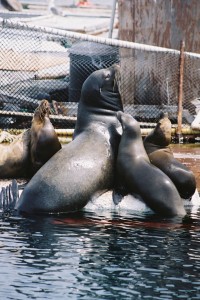
Photo credit: Mark McDermott
Imagine the challenges of dating someone four times your size, especially during the intimate times. This is the reality of a female California sea lion.
Well-known residents of the South Bay, California sea lions, officially named Zalophus californianus, are frequently seen swimming near shore, chasing fish or lounging on buoys. But what goes on behind the scenes in the life of a California sea lion is much more interesting.
The California sea lion suffers from or is blessed with, depending on your point of view, sexual dimorphism—visible body shape differences between females and males of the same species or in this case very extreme visible differences. Male sea lions average around 800 pounds, almost four times the average female, who typically weighs in closer to 200.
This massive size difference begs one question: How does this work in the bedroom? Are females forced into submission by males using World Wrestling Entertainment style maneuvers? Or do females band together to develop a good offense forcing males to negotiate in good faith or lose the opportunity to bring forth the next generation?
Well, not exactly.
According to the Encyclopedia of Marine Mammals, females are quite picky about appropriate behavior and do not tolerate males who are rowdy, annoying, or aggressive. If a male sea lion uses one of these ill advised dating strategies, females vote with their flippers and swim off to find a more refined suitor to meet their needs.
If a male makes a last ditch effort to lure her back by blocking her escape route, the female sticks her neck up and out and swings her head from side to side like an elongated bobble-head, body language demanding free passage. Most males give in, but the dense male who doesn’t suffers flipper slapping and mad hopping and then he finally gets the hint and backs down.
But do males really give up on sex that easily? A few neck moves and flipper slaps is all it takes for females to ward off males almost four times as large?
Actually, females rely on an unlikely ally for males to truly listen—the heat.
California sea lions are constantly working to maintain a comfortable body temperature, as they move from water to land and back again. Fully adapted to survive in the ocean, sea lions have thick blubber and fur to insulate them from cold water. But mating takes place on land under the glaring California sun where this extra insulation becomes a burden.
Imagine weighing 700 plus pounds wearing a winter down coat and two layers of thermal underwear and chasing after women while the sun relentlessly shines during a 90 degree day. Not a good idea. Especially for male sea lions who put on extra pounds to survive more than a month without food during mating season. This allows a male to maintain and defend a territory fulltime as he fights off other males at established rookeries (breeding areas) on the Channel Islands.
Heat may also affect a male’s decision to step aside at a much deeper level.
Fullerton College professor and California sea lion researcher Carolyn Heath theorizes that if males did not allow females to leave as requested that females could overheat on land and ultimately die. This lurking possibility gives male sea lions another reason to tolerate the cold-shoulder attitude and to patiently wait for another opportunity to breed ensuring the ongoing success of their genes.
And for all the dirty minds out there still wondering…based on Heath’s observations females mount the males as part of courtship and to indicate interest, but once a male receives the green light he then mounts the female. Heath explained, “It wouldn’t work physically otherwise. That may be one of the reasons they seem to prefer mating in shallow pools of water or right along the shoreline; all that blubber on the male does float well, which takes some of his weight off of her. I won’t even get into the sandy bottom issue—ouch!”
So despite the huge size of male sea lions, females call most of the shots, proving that size doesn’t always matter, especially when the laws of physics are working in your favor.
[…] I have already written about California sea lions, I’m going to focus more on Galapagos and Japanese sea lions in this post. But alas, not as […]